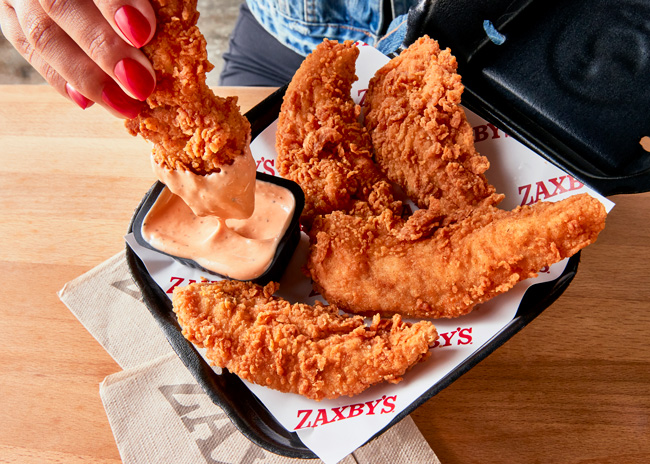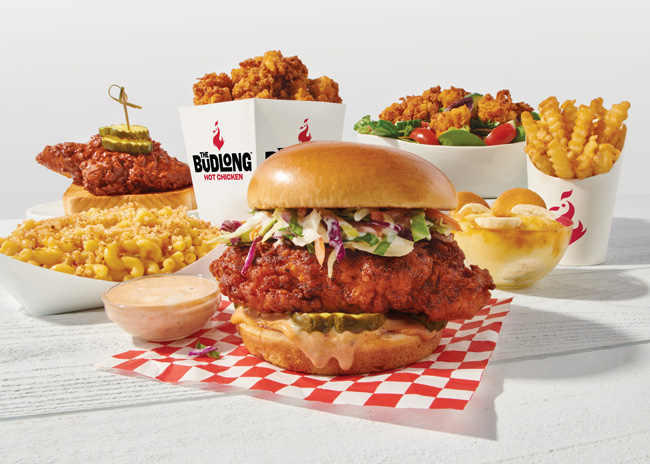As restaurant patrons become more sensitive to price increases, chicken remains an attractive menu choice, both for diners and operators.
 Photo courtesy of Zaxby’sA report on the CNBC business channel earlier this year noted that 2024 could very well be “the year of chicken for restaurants” due to three main factors: its popularity with younger consumers; the higher margins it affords in comparison to beef; and the success of some privately held chicken restaurant chains, such as Chick-fil-A. So whether it’s a humble chicken sandwich at the local mom-and-pop or the poulet rôti (roast chicken) at an upscale white tablecloth restaurant, chicken appears to have a solid place on today’s menu.
Photo courtesy of Zaxby’sA report on the CNBC business channel earlier this year noted that 2024 could very well be “the year of chicken for restaurants” due to three main factors: its popularity with younger consumers; the higher margins it affords in comparison to beef; and the success of some privately held chicken restaurant chains, such as Chick-fil-A. So whether it’s a humble chicken sandwich at the local mom-and-pop or the poulet rôti (roast chicken) at an upscale white tablecloth restaurant, chicken appears to have a solid place on today’s menu.
Refreshing a Classic
Given chicken’s continuing popularity across the board, restaurants that specialize in chicken keep finding new ways to stay on top of their game. One 60-year-old chain, Lee’s Famous Recipe Chicken, is in the midst of a complete refresh, according to CEO Ryan Weaver. “We started our brand refresh process in the middle of 2022,” he says. “We took a good amount of time up front to make sure we found the right design firm who understood who we were and our history.” Customer research helped the company understand what customers liked about the brand and what they might want to see improved.
It’s a refresh and redesign from the ground up for this 130-unit chain, and it touches everything from the dining room design to the floor finishes to the chain’s logo. The first unit to receive the complete refresh opened in Wayne, Mich., in January of this year; two more units are receiving the makeover, too. By the end of 2024, the chain’s franchisees and licensees will get the timeline for their revamps.
Despite the aesthetic update, the chain’s kitchen will stay pretty much the same. As one might expect for a fried chicken concept, Weaver says, “the fryers are really the engine of the whole restaurant.” Lee’s uses both pressure fryers and open fryers to produce its chicken products, which include both traditional parts and dippable breast strips. Weaver says the average Lee’s unit has about five pressure fryers and two open fryers. Given regional menu variations and volume, some stores may have more fryers. “You’ll find at least two breading tables in all our restaurants — sometimes three — an oven, a steamer and at least one marinator because we marinate our product in-house,” he says. Four standup warming cabinets keep product warm until serving time. Weaver says that as Lee’s third-party takeout business expands, they may look into customer-facing equipment for product pickup.
Despite the heavy competition, Weaver feels that fried chicken restaurants have two main advantages over other restaurants in the quick-serve segment. “When you start breaking down how many folks you can feed and what the cost is of one of our family meals, it’s an incredible value relative to buying four burger combos at a QSR,” he says. “And if I want a burger, I can go to a grocery store and get [beef], throw it on the grill at home and it’s pretty good. When you’re talking about fried chicken, it’s something that customers can’t really make at home in their own kitchens the same way and have it taste as good as if they were come to a Lee’s and get it.”
 Lee’s Famous Recipe Chicken restaurants are getting a company-wide refresh over the next few years.
Lee’s Famous Recipe Chicken restaurants are getting a company-wide refresh over the next few years.
Specializing for Success
With more than 940 units, primarily in the Southeast U.S., specialization has been the key to success for the 34-year-old Zaxby’s chain. “From the start, we’ve placed chicken fingers at the forefront of our menu offerings,” says Ali Ghosh, Zaxby’s vice president of brand strategy. The chain’s menu emphasizes its Chicken Fingerz and wings, offering them in a variety of forms, such as the two-bite Nibblerz sandwich (a chicken finger on a bun), with a full complement of 12 dipping sauces. Whole breasts and thighs aren’t on the menu, but salads using chopped Fingerz are. Keeping the menu narrowly focused, Ghosh says, “allows us to focus on perfecting those favorites.”
Getting customers to think about chicken fingers as something more than a snack has presented a challenge, but Zaxby’s has overcome that by positioning the fingers as an entree option. By offering a variety of full-meal combos that pair the fingers or wings with sides such as fries, coleslaw and Texas toast, “we transformed how guests think about Chicken Fingerz as a meal option and made it the star of the show,” Ghosh says.
The equipment lineup in a typical Zaxby’s kitchen is fairly straightforward, according to Pat Fries, vice president of supply chain and purchasing. “Our kitchen is equipped with key components, such as a breading station, fryers, a flattop griddle and production line.” A cross-functional team including “supply chain, operations, culinary, development and finance,” Fries says, makes the equipment decisions. The chain leverages its size with manufacturers and distributors as necessary to find the right equipment and “measures success through various factors, including how well the equipment performs in delivering top-notch guest experiences, its impact on improving team member satisfaction, and how it contributes to overall sales and profits,” says Fries.
 The heart of The Budlong’s menu is its Nashville hot chicken and Southern-style sides and desserts.
The heart of The Budlong’s menu is its Nashville hot chicken and Southern-style sides and desserts.
Heating it Up
With a menu based around Nashville-style hot chicken, The Budlong capitalizes on customer desires for new flavors. Established in 2016, the Chicago-based chain has five locations open, with seven more under construction. It began franchising last year, and according to Gregg Majewski, founder and CEO of Craveworthy Brands, The Budlong’s parent company, “we hope to close between 30 and 50 locations before the end of 2024.”
Nashville hot chicken is the centerpiece of The Budlong’s menu. The chicken is “hand-breaded, never frozen, and the big difference is that it gets painted with sauce and deep fried,” says Majewski. Patrons who want something even bolder can opt for an extra-hot version, and the chain has also added honey barbecue and garlic parmesan flavors. The Budlong offers a range of traditional sides and desserts, such as hush puppies, corn bread and banana pudding.
All items are prepared in The Budlong’s kitchens, which range in size from 300 to 500 feet. The chain uses a fairly basic equipment package, says Majewski. “When you’re dealing with fried chicken, a small flattop, four high-recovery fryers, an oven to bake our homemade biscuits, a couple of cold tables and breading station is all we need,” he says. And although The Budlong does work with third-party delivery services, as of yet it has not installed any equipment in the front of the house to facilitate pickup.
The Budlong’s purchasing and culinary teams make the call on new equipment purchases, Majewski says. “They walk us through the decisions, and we test them in stores prior to making any switch.” Majewski has no problem upgrading equipment when necessary. “I have learned that there are certain pieces of equipment that you’re just better off buying — it’s cheaper to replace them than replacing the compressor in three to four years,” he says.
Majewski believes the versatility of chicken serves as a major reason for its continuing popularity. On the operational side, he says that “chicken’s a blank canvas that you can do almost anything with.” From a customer perspective, “it’s perceived to be healthier. Maybe not fried … but for whatever reason, it’s perceived to be healthier than eating steak all the time.”



